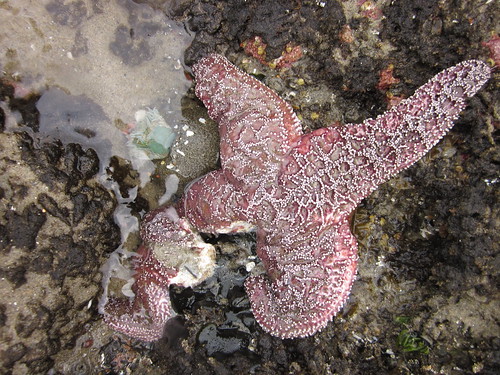“1986-014-01: Sunflower seastar” by August Rode is licensed under CC BY-SA 2.0
Once an abundant species of sea star, the sunflower sea stars have become harder to find on the West Coast of North America. A recent study co-led by the University of California, Davis, and Cornell University claims that the combination of ocean-warming and an infectious wasting disease has led to the declined population of these large sea stars.
The sunflower sea star is one of the largest sea star species, they can grow as big as manhole covers. Commonly found in the northwest Pacific, they were once regularly found from Southern California to Alaska and some of the largest sunflower sea stars could be found in Puget Sound, British Columbia and Alaska.
In 2013 and 2014, a disease called sea star wasting syndrome affected around 40 different species of sea stars, including the sunflower sea star, to die off along the North American Pacific coast. Symptoms of the disease would be lesions and tissue decay, which the body structure of the sea star would start to breakdown. For example, their arms may twist and fall off and the sea stars would become limp. Eventually, the sea star would disintegrate and melt away into a white, mushy blob and no longer be a sea star. It is unclear where this disease originated from but researchers believe ocean-warming might be the reason why this disease continues to affect the sea stars and why the sea star population is not recovering fast enough.
“Dying sea star” by Oregon State University is licensed under CC BY-SA 2.0
Ocean-warming is an effect of global warming. The ocean absorbs excess heat from the atmosphere which contains greenhouse gas emissions, which leads to rising ocean temperatures. Increasing ocean temperature can affect many marine species and ecosystems. Warming of the oceans have been linked to the increase and spread of diseases of marine species.
The sunflower sea star species has been detrimentally affected by sea star wasting syndrome. The study conducted by Dr. Harvell and her colleagues collected data over eleven years to show how the population of sea stars have diminished due to this disease. In addition, scientists also found that the ocean water has warmed almost 4 oC within a four-year span in some areas. Results of the study showed the population crash of sunflower sea stars from Southern California to Alaska whilst tracking patterns of unusual warming in the Pacific Ocean. The sunflower sea star is shown to be highly susceptible to this wasting disease because they do not have a complex immune system. As a result, the data showed an 80 to 100% decline over the period of the study.
“Sunflower Star Imperiled by Sea Star Wasting Epidemic” by Hakai Institute
If the sunflower sea star dies off, this should be an important indicator of the effects of ocean-warming and its impact on marine ecosystems. Sunflower sea stars are voracious predators in the deep and shallow waters of the northwest Pacific, and if these sea stars were to go away we could see an unbalanced ecosystem in our waters.
– Katherine Lam


